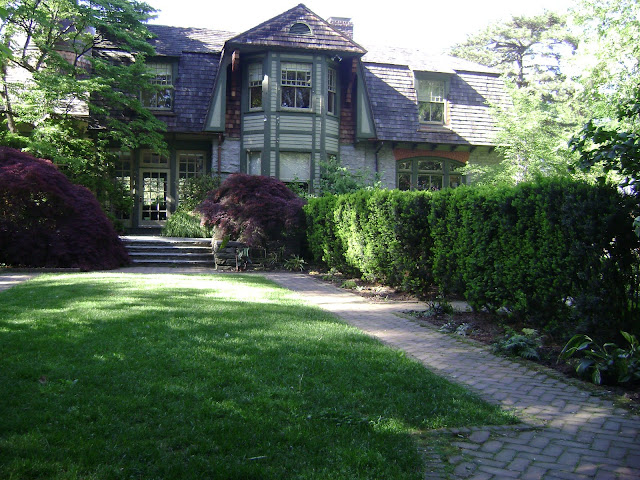I realized, while looking over the meager blog, that I haven't spent much time describing the Scott Arboretum with respect to its particular qualities as a garden/arboretum/educational center. This is unfortunate, as Scott, as well as all the gardens I have visited thus far, have all profoundly different personalities, and I am remiss in waiting so long to introduce the arboretum with which I am the most familiar.
If Longwood is a powerful juggernaut which pummels its views with spectacle, and Mt. Cuba Center endeavors to create beautiful and subtle naturescapes that sink into the surrounding woods, Scott Arboretum is a conscious attempt on the part of its creators to provide collections and gardens that sink into the human community: this is an arboretum that is both physically and philosophically connected to both the college and the town of Swarthmore.
Thus the word you should associate with Scott Arboretum is: community.
 But first some facts and figures. The Scott Arboretum is home to over 300 square acres and 3,000 different plants. It was created in 1929, and acts as a living memorial to Arthur Scott, a Swarthmore alumna, with the goal of encouraging horticulture in the "broadest sense" by acting both as a "visual demonstration" of planting techniques and species that thrive in the area, and by sinking these displays firmly in the hands of the public.
But first some facts and figures. The Scott Arboretum is home to over 300 square acres and 3,000 different plants. It was created in 1929, and acts as a living memorial to Arthur Scott, a Swarthmore alumna, with the goal of encouraging horticulture in the "broadest sense" by acting both as a "visual demonstration" of planting techniques and species that thrive in the area, and by sinking these displays firmly in the hands of the public.
The Cunningham House, where the main offices of the arboretum are located:
The view from the Shane garden.
 Scott relies heavily on the community for support, and in return, provides significant benefits. Almost everyday members of the community, as Arboretum Assistants, can be seen performing all sorts of maintenance activities, volunteering their time to keep the arboretum looking beautiful. On a personal note, these volunteers have been absolutely welcoming and a pleasure to work with, and they get work done.
Scott relies heavily on the community for support, and in return, provides significant benefits. Almost everyday members of the community, as Arboretum Assistants, can be seen performing all sorts of maintenance activities, volunteering their time to keep the arboretum looking beautiful. On a personal note, these volunteers have been absolutely welcoming and a pleasure to work with, and they get work done.
It has also been fascinating to watch the students interact with the arboretum in subtle ways, its amazing how you come to learn what you see. I have seen many students stop mid-conversation to check a tag. Scott also provides classes, tours, trips to other gardens both near and far, and information about garden issues outside the arboretum, such as "my hollies are being killed by something could you please have a look?"
Green building, LEED certification, celebrating arbor day with first graders and handing out trees, is just a part of how Scott inspires the individuals it engages with, by showing people how easy it is, and how beautiful it can be, to cultivate community by providing a beautiful space that people feel personally connected to.
Scott has a bunch of impressive collections ranging from magnolias to tree peonies to hollies. They also have a variety of seasonal gardens that put on an impressive display all year long. Some of these seasonal gardens have specific themes, and specific plants they highlight. For example the Dean Rose garden is all roses, and the Harry Wood garden has a contemporary rock garden feel to it. The Cosby garden features containers planted with conifers in the colder months and tropicals in the warmer ones, plus a small collection of climbing vines. Plus, there are just a bunch of plants around that aren't in a particular garden or collection that are gorgeous:
 Rhododendron canescens x austrinum
Rhododendron canescens x austrinum Scott also benefits from being totally embedded within the Swarthmore college campus, so there is also beautiful architecture everywhere. Like the bell tower, and the mysterious amphitheater.
Scott also benefits from being totally embedded within the Swarthmore college campus, so there is also beautiful architecture everywhere. Like the bell tower, and the mysterious amphitheater. Really, Scott is more like a library than a for profit garden: its free, has huge amounts of information about the history and composition of its plants, everything is well labeled, the staff is small and knowledgeable, and it is easy to explore the space on your own, at your own pace. It is quiet, well organized, and provides a huge amount of information.
Really, Scott is more like a library than a for profit garden: its free, has huge amounts of information about the history and composition of its plants, everything is well labeled, the staff is small and knowledgeable, and it is easy to explore the space on your own, at your own pace. It is quiet, well organized, and provides a huge amount of information.
As a side note, it is also a great place to work.
Adventure is out there.
Adventure is out there.




No comments:
Post a Comment